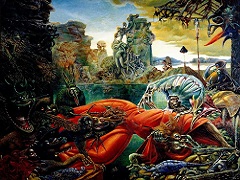Attirement of the Bride, 1940 - by Max Ernst

Attirement of the Bride is an example of Max Ernst's veristic or illusionistic Surrealism, in which a traditional technique is applied to an incongruous or unsettling subject. The theatrical, evocative scene has roots in late nineteenth-century Symbolist painting, especially that of Gustave Moreau. It also echoes the settings and motifs of sixteenth-century German art. The willowy, swollen-bellied figure types recall those of Lucas Cranach the Elder in particular. The architectural backdrop with its strong contrast of light and shadow and its inconsistent perspective shows the additional influence of Giorgio de Chirico, whose work had overwhelmed Ernst when he first saw it in 1919.
The pageantry and elegance of the image are contrasted with its primitivizing aspects - the garish colors, the animal and monster forms - and the blunt phallic Symbolism of the poised spearhead. The central scene is contrasted as well with its counterpart in the picture-within-a-picture at the upper left. In this detail the bride appears in the same pose, striding through a landscape of overgrown classical ruins. Here Ernst has used the technique of decalcomania invented in 1935 by Oscar Domínguez, in which diluted paint is pressed onto a surface with an object that distributes it unevenly, such as a pane of glass. A suggestive textured pattern results.
The title of this work had occurred to Ernst at least as early as 1936, when he italicized it in a text in his book Beyond Painting. Ernst had long identified himself with the bird, and had invented an alter ego, Loplop, Superior of the Birds. As well as an erotic fantasy, this is a meditation on creativity. The painting within the painting is a clue. Ernst opened himself to images, he claimed, just as Leonardo da Vinci advised artists to do, by staring at a stain. You will see in the stain, said Da Vinci as quoted by Ernst, "human heads, various animals, a battle... "
The works echoes the influence of Leonardo da Vinci's Leda and the Swan. In the arbitrary red form that emerged in his small decalcomanic image, Ernst saw the bride being robed; in the completed, large painting this is fleshed out as a complex history. It is Leonardo's method exactly.
















